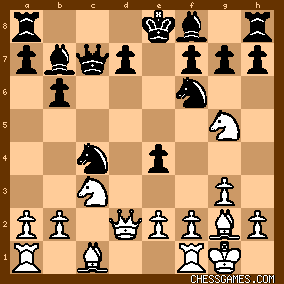| Nov-12-07 | | patzerboy: Poor Vera. So many tries in so many games, but Capa never seems to break a sweat. At least she shows spirit in every game. |
|
| Feb-27-10 | | M.D. Wilson: Indeed she does. |
|
| Feb-16-11 | | twin phoenix: i've seen many of her games and she was a strong player! |
|
| Feb-16-11 | | AGOJ: No offense, but why "poor Vera"? She has a record to be proud of, even if she didn't ever win against Capa. (This is the 1920s Capablanca, after all! It took an Alekhine to win against him.) In my opinion she would have gotten a better record if she played her openings better. In here, for example, she plays for quick castling (compare with Capa's play), and is forced to bring the Queen out too early to the center, where the White Queen is harassed by pawns. This gains Black tempos used to build a central space advantage. With control of the center, Black's middle game was easier to play (he certainly didn't worry about his King's safety), and the inevitable follow up was an attack against the castled position. She was definitely outclassed in her understanding of the necessities of the position coming out of the opening, but still, most players would. |
|
Jun-17-15
 | | Honza Cervenka: 11.Qf4 Bd6 12.Nxe4 was interesting. |
|
| Jun-19-16 | | edubueno: 2nd complete point of Capa |
|
| Feb-16-18 | | RookFile: I think the point of the opening is white is supposed to play c4 a little sooner. For example, 3. c4 is fine. After Capa's sharp ...c5 thrust, d5 is not an option for white. But had white played 3. c4 then ...c5 is answered with d5 and white is happy. |
|
Feb-16-18
 | | keypusher: <11.Qf4 Bd6 12.Nxe4 was interesting.> Shredder thinks White would have been slightly better after <Honza>'s move, e.g. 11.Qf4 Bd6 12.Nxe4 Bxe4 13.Bxe4 Nxc4 14.Qf5 Rc8 15.Bd3 and +0.47 after four minutes (36/49). |
|
| Mar-12-21 | | Gaito: An interesting moment of the game:

click for larger view
BLACK TO MOVE
Obviously Black is clearly better with two extra pawns and a firm control of the central squares. However, there is only one little drawback in Black's position, and that is his lack of development, as he still needs some time to get his rooks into the game, whereas White has already finished the development of her pieces.
It was probably in this position that Capablanca relaxed his attention a little ("dizziness due to success"), and played the feeble 22...Bc6? (A more sensible move would have been 22...Qe7). Assuming that White will sit and do nothing, the move 22...Bc6 has the only purpose of placing this bishop on a defended square, in preparation for the eventual advance of his central pawns. Yet the move is still neglecting to hurry up with the development of his rooks!
White could have taken advantage of that omission with a powerful exchange sacrifice:
23...Bc6?! 24.Rxc5! bxc5 25.Bd6+ Kg8 26.Bxc5 Rb8 27.Qd2(=/∞) (diagram)

click for larger view
BLACK TO MOVE
This position is not so easy to play for Black, as he has a weakness complex on the dark squares and his King's rook has not been developed yet, moreover his pieces are lacking coordination. White, on the othe hand, is down a pawn and an exchange, but has a superior position and more space. Very likely Capablanca would have managed to win this position as Black, but it would have been far more difficult for him as compared to the actual game. |
|
| Mar-12-21 | | Gaito: Why did miss Menchik get such a bad position as White out of the opening? It is not difficult to find out. At least a couple of times she picked out the wrong square for her queen when this piece was under attack, and that meant to waste a few valuable tempi. See for example the position below:

click for larger view
Where should White retreat her attacked queen?
Miss Menchik chose 8.Qf4? presumably proposing the exchange of queens, a plan that would be good, were it not for the fact that Black is prepared to reply with 8...e5!, chasing White's queen again with tempo. Then she played 9.Qd2? thereby picking out another bad square for her queen (perhaps 9.Qh4 would have been in order). Further, there followed 9...e4!? 10.Ng5 (⌓ 10.Nh4) Ne5 (10...Bb4 deserved some attention) 11.Nc3? (an oversight. 11.Qf4! would have been much better) 11...Nxc4 reaching the position depicted in following diagram:

click for larger viewWhere should White move her attacked queen? Correct is maybe 12.Qc2 with equality. But miss Menchik again chose the worst square for her queen: 12.Qd4??, giving her opponent a perfect chance to develop yet another piece with tempo later on (....Bc5).
After 12.Qc2, a possible continuation would have been 12...d5 13.Bf4 Nd6 (13...Bd6? 14. Nb5!⩲) 14.Rfd1 with equality (see diagram):

click for larger view |
|
|
|
|





